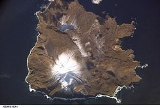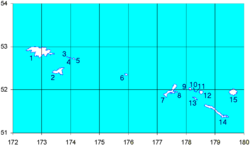
Little Sitkin Island
Encyclopedia


Volcano
2. Bedrock3. Conduit 4. Base5. Sill6. Dike7. Layers of ash emitted by the volcano8. Flank| 9. Layers of lava emitted by the volcano10. Throat11. Parasitic cone12. Lava flow13. Vent14. Crater15...
island in the Rat Islands
Rat Islands
The Rat Islands are a volcanic group of islands in the Aleutian Islands in southwest Alaska, between Buldir Island and the Near Islands group to its west, and Amchitka Pass and the Andreanof Islands group to its east, at about ....
archipelago of the Western Aleutian Islands, Alaska
Alaska
Alaska is the largest state in the United States by area. It is situated in the northwest extremity of the North American continent, with Canada to the east, the Arctic Ocean to the north, and the Pacific Ocean to the west and south, with Russia further west across the Bering Strait...
, about three miles east of Davidof Island. Great Sitkin Island
Great Sitkin Island
Great Sitkin Island is a volcanic island in the Andreanof Islands of the Aleutian Islands of Alaska. The island covers a total area of and lies slightly north of a group islands which are located between Adak Island and Atka Island....
(which is essentially the same size as Little Sitkin) lies 185 mi (295 km) further east in the Andreanof Islands
Andreanof Islands
The Andreanof Islands are a group of islands in the Aleutian Islands in southwest Alaska. They are located between Amchitka Pass and the Rat Islands group to the west, and Amukta Pass and the Islands of Four Mountains group to the east, at about 52° North and 172°57' to 179°09' West. The islands...
.
Little Sitkin is roughly circular and about 6 miles in diameter. The interior is extremely rugged and mountainous; only the lower slopes are grass covered. There are two prominent peaks, one 3,898 feet high in the northeast part of the island and the other 1,960 feet high in the southern part. Numerous streams are on the island but no lakes or ponds. The coast is generally bold, rocky, and precipitous, with a fringe of kelp 200 to 400 yards wide. Small steam jets and hot springs are in the valley at the head of William Cove on the northwest of the island.
The Volcano
Little Sitkin is a stratovolcano that erupted probably in 1776, 1828, and 1900. The 1776 eruption was probably explosive. The volcano has had three cone building episodes separated by the formation of two calderas. A summit crater caps the youngest cone, about 3 miles in diameter at the base.The active stratovolcano on Little Sitkin Island occurs within the eroded remnants of a nested double caldera of probable late Pleistocene age. The older caldera (Caldera One) is about 4.8 km in diameter and is centered slightly northeast of the island's midpoint. The caldera formed at the site of a large stratovolcano, the remnants of which are the oldest rocks exposed on the island.
A second stratovolcano was constructed almost entirely of lava flows within Caldera One and attained a height of about 900 m. A cataclysmic eruption, possibly in early post-glacial time, resulted in the formation of a second, smaller caldera (Caldera Two) that partially destroyed this cone. Caldera Two is elliptical in outline and measures 2.7 by 4 km; the inferred eastern and southern margins are coincident with those of Caldera One. Field relations suggest that the northern boundary of Caldera Two is a hinge along which a large block, comprising most of the Caldera One stratovolcano, was tilted southward during the caldera eruption. The highest peak on the island is on the post-caldera remnant of the second cone.
A deposit of partly welded tuff up to 100 m thick extends from the remnant cone northwest across the Caldera Two boundary fault, to slightly beyond the inferred location of the Caldera One boundary fault. The deposit is thought to have been emplaced by one of more pyroclastic flows, possibly associated with formation of Caldera Two.
Post-Caldera Two deposits are mainly lava flows. Two relatively recent aa flows have well developed levees; one originated from the breached central crater of Little Sitkin volcano, and the other from a fissure along the western trace of the Caldera One boundary fault.
External links
- Little Sitkin Photos Photographs from Little Sitkin Island, July 2008

